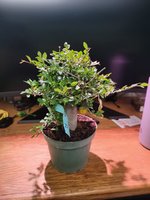Isilwen
Mame
I just got home from work and pulled it out of its shipping box. It's a decent little tree. Nothing remarkable about the roots. I did find one thicker root it looks like to me, but it was cut at some point. You might be able to see that in the one photo I took. I do like the straightness of the trunk. However, I'm not sure that a formal upright is in the cards for it as the trunk was definitely cut. I can see where the trunk stops. I am guessing a broom style is what I am looking at, which is what I was going to do if formal upright wasn't in the cards or it lent itself more to a broom style bonsai. I could be wrong though.
Not sure what to do from this point. The instructions said to leave it in the shade for a few days to get over the shock of shipping and then put it in the sun. It also said to wait to repot till it acclimates to the new location. So I will do those things for sure.
What is your take on this little tree and how you would style it and your next steps?





Not sure what to do from this point. The instructions said to leave it in the shade for a few days to get over the shock of shipping and then put it in the sun. It also said to wait to repot till it acclimates to the new location. So I will do those things for sure.
What is your take on this little tree and how you would style it and your next steps?












